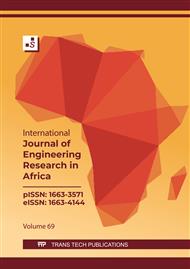[1]
Y. L. Fang, Z. Y. Liu, W. Y. Xue, H. M. Song, and L. Z. Jiang, "Duplex Stainless Steels' 94, Proc. Conf., Glasgow, England Duplex Stainless Steels' 94, Proc. Conf., Glasgow, England K1, 1994," ISIJ Int., vol. 50, no. 2, p.286–293, 2010.
DOI: 10.2355/isijinternational.50.286
Google Scholar
[2]
K. Y. Benyounis, A. G. Olabi, and M. S. J. Hashmi, "Multi-response optimization of CO2 laser welding process of austenitic stainless steel," 2008.
DOI: 10.1016/j.optlastec.2007.03.009
Google Scholar
[3]
S. Geng, J. Sun, L. Guo, and H. Wang, "Evolution of microstructure and corrosion behavior in 2205 duplex stainless steel GTA-welding joint," J. Manuf. Process., vol. 19, no. September 2018, p.32–37, 2015.
DOI: 10.1016/j.jmapro.2015.03.009
Google Scholar
[4]
K. Ogawa and Y. Yamadera, "Weldability of super duplex stainless steel," p.1–12, 2015.
Google Scholar
[5]
S. de Alencar Pires, M. F. de Campos, C. J. Marcelo, and C. R. Xavier, "Secondary austenite precipitation during the welding of duplex stainless steels," in Materials Science Forum, 2016, vol. 869, p.562–566.
DOI: 10.4028/www.scientific.net/msf.869.562
Google Scholar
[6]
M. A. Makhdoom, A. Ahmad, M. Kamran, K. Abid, and W. Haider, "Microstructural and electrochemical behavior of 2205 duplex stainless steel weldments," Surfaces and Interfaces, vol. 9, p.189–195, 2017.
DOI: 10.1016/j.surfin.2017.09.007
Google Scholar
[7]
E. M. Westin, "Microstructure and properties of welds in the lean duplex stainless steel LDX 2101." KTH, 2010.
Google Scholar
[8]
A. R. Pimenta, M. G. Diniz, G. Perez, and I. G. Solórzano-Naranjo, "Nitrogen addition to the shielding gas for welding hyper-duplex stainless steel," Soldag. e Insp., vol. 25, p.1–8, 2020.
DOI: 10.1590/0104-9224/SI25.12
Google Scholar
[9]
A. Baghdadchi, V. A. Hosseini, K. Hurtig, and L. Karlsson, "Promoting austenite formation in laser welding of duplex stainless steel—impact of shielding gas and laser reheating," Weld. World, vol. 65, no. 3, p.499–511, 2021.
DOI: 10.1007/s40194-020-01026-7
Google Scholar
[10]
Xie, X., Li, J., Jiang, W., Dong, Z., Tu, S.-T., Zhai, X., & Zhao, X "Nonhomogeneous microstructure formation and its role on tensile and fatigue performance of duplex stainless steel 2205 multi-pass weld joints," Mater. Sci. Eng. A, vol. 786, p.139426, 2020.
DOI: 10.1016/j.msea.2020.139426
Google Scholar
[11]
J.-S. Kwak, "Application of Taguchi and response surface methodologies for geometric error in surface grinding process," Int. J. Mach. tools Manuf., vol. 45, no. 3, p.327–334, 2005.
DOI: 10.1016/j.ijmachtools.2004.08.007
Google Scholar
[12]
V. Gunaraj and N. Murugan, "Application of response surface methodology for predicting weld bead quality in submerged arc welding of pipes," J. Mater. Process. Technol., vol. 88, no. 1–3, p.266–275, 1999.
DOI: 10.1016/s0924-0136(98)00405-1
Google Scholar
[13]
G. E. P. Box and K. B. Wilson, "On the experimental attainment of optimum conditions," Break. Stat. Methodol. Distrib., p.270–310, 1992.
Google Scholar
[14]
M. S. Sharma, "Study of Mechanical Properties in Austenitic Stainless Steel Using Gas Tungsten Arc Welding (GTAW) et al Int," J. Eng. Res. Appl., p.547–553, 2013.
Google Scholar
[15]
K. D. Ramkumar et al., "Effect of optimal weld parameters in the microstructure and mechanical properties of autogeneous gas tungsten arc weldments of super-duplex stainless steel UNS S32750," Mater. Des., vol. 66, p.356–365, 2015.
DOI: 10.1016/j.matdes.2014.10.084
Google Scholar
[16]
Korra, Nanda Naik , Balasubramanian, K R and M. Vasudevan, "Optimization of activated tungsten inert gas welding of super duplex alloy 2507 based on experimental results," Proc. Inst. Mech. Eng. Part B J. Eng. Manuf., vol. 229, no. 8, p.1407–1417, 2015.
DOI: 10.1177/0954405414537245
Google Scholar
[17]
T. Elrabei and E. Anawa, "Study the Effect of Autogeneous Semiautomatic TIG Welding Process Parameters on Mechanical Properties of AISI304L Austenitic Stainless Steel Joints Using Taguchi Method ," MATTER Int. J. Sci. Technol., vol. 18, p.1–22, Sep. 2019.
Google Scholar
[18]
E. M. and F. M. Ibrahem.Z, "Controlling and modelling TIG welding of duplex stainless steel using Taguchi method," University of Benghazi, 2019.
Google Scholar
[19]
S. Mondal, P. K. Pal, and G. Nandi, "Optimization of process parameters of TIG welding of duplex stainless steel without filler rod by grey-Taguchi method," Indian J. Eng. Mater. Sci., vol. 28, no. 4, p.385–392, 2021.
DOI: 10.56042/ijems.v28i4.41385
Google Scholar
[20]
S. Cui, Y. Shi, K. Sun, and S. Gu, "Microstructure evolution and mechanical properties of keyhole deep penetration TIG welds of S32101 duplex stainless steel," Mater. Sci. Eng. A, vol. 709, p.214–222, 2018.
DOI: 10.1016/j.msea.2017.10.051
Google Scholar
[21]
A. V. Jebaraj and L. Ajaykumar, "Influence of microstructural changes on impact toughness of weldment and base metal of duplex stainless steel AISI 2205 for low temperature applications," Procedia Eng., vol. 64, p.456–466, 2013.
DOI: 10.1016/j.proeng.2013.09.119
Google Scholar
[22]
F. Mirakhorli, F. Malek Ghaini, and M. J. Torkamany, "Development of weld metal microstructures in pulsed laser welding of duplex stainless steel," J. Mater. Eng. Perform., vol. 21, no. 10, p.2173–2176, 2012.
DOI: 10.1007/s11665-012-0141-3
Google Scholar


